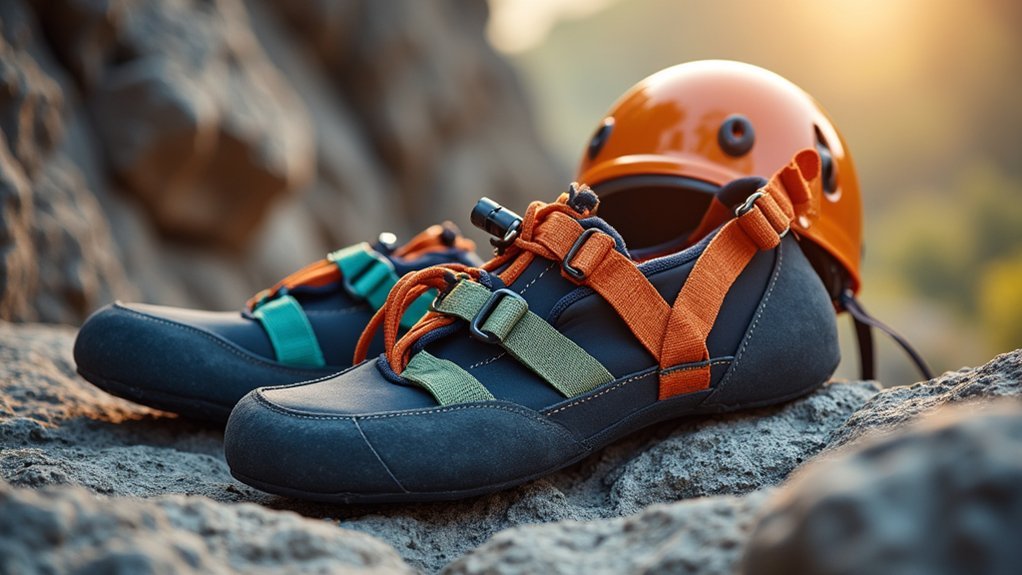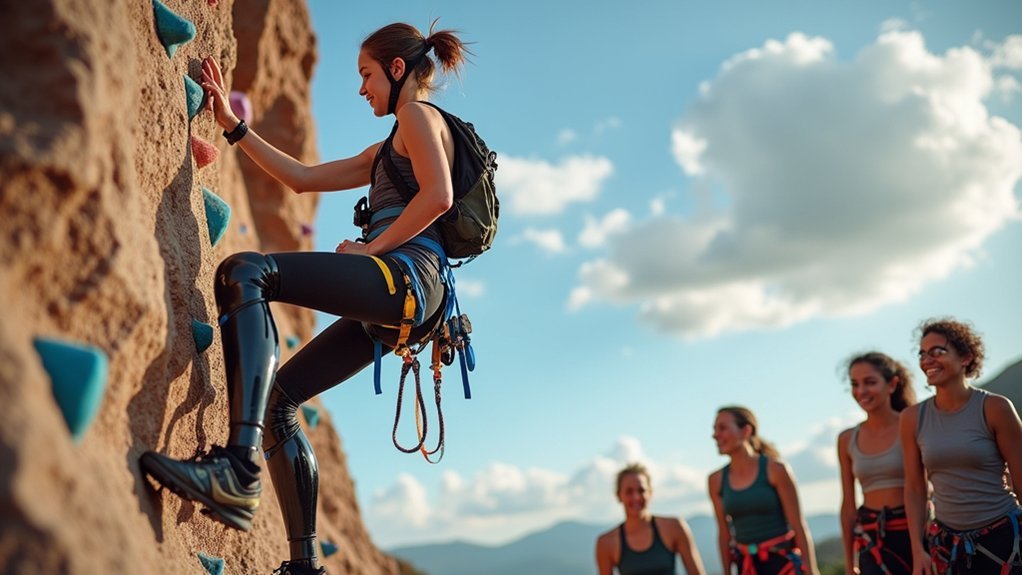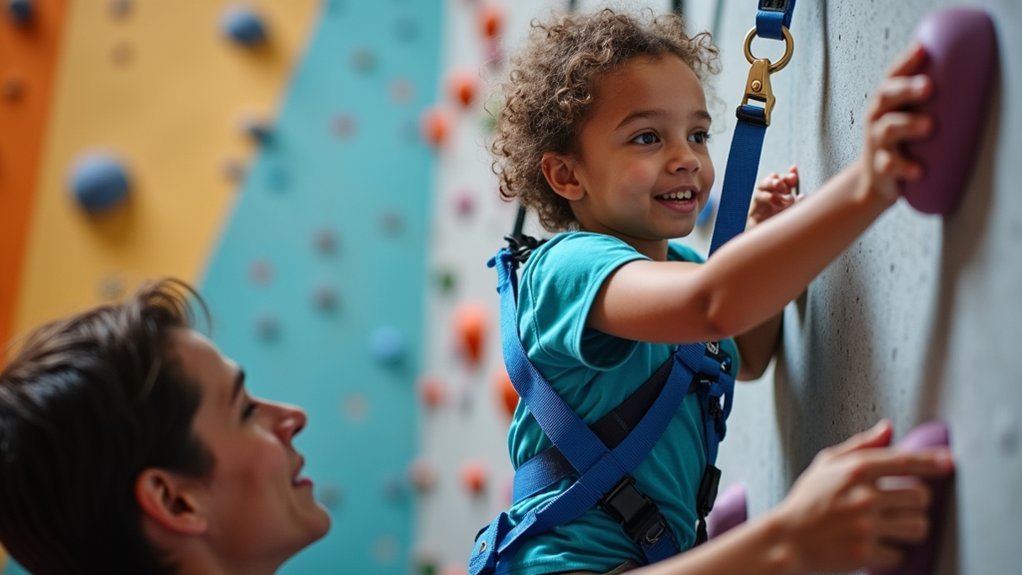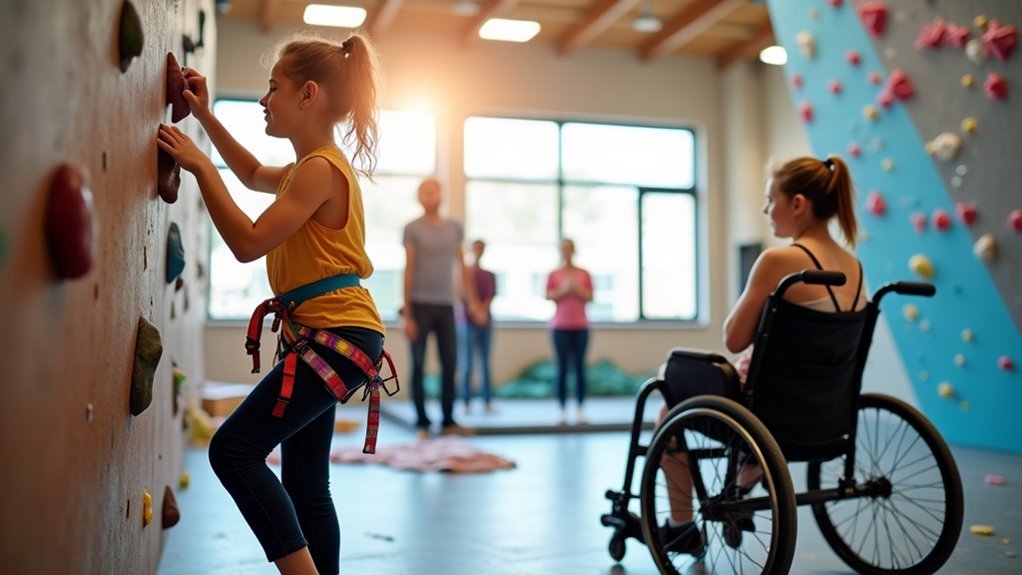Adaptive climbing gear provides essential support for beginners with varying abilities. You’ll benefit from specialized harnesses like the Easy Seat ($479.95) or Arc Harness ($579.95) with wider, padded straps for comfort. The Wellman Pull Up Bar ($499.95) creates mechanical advantage, reducing strength needed for ascents. Adaptive prosthetics enhance grip and stability, while specialized climbing shoes offer better control. Community resources through organizations like Adaptive Climbing Group often provide equipment access. Discover how this gear transforms your climbing journey.
Understanding Adaptive Harnesses for New Climbers

While traditional climbing gear might seem intimidating, adaptive harnesses open the door to rock climbing for beginners of all abilities. These specialized systems offer essential support while you learn the fundamentals of climbing technique.
The Easy Seat Harness delivers exceptional comfort at $479.95, featuring lightweight, adjustable components perfect for your first climbing adventures.
For enhanced stability, consider the Arc Harness starting at $579.95, engineered to provide security across various climbing environments.
If you need maximum support, the Wellman ARC Harness begins at $699.95 and delivers a secure fit tailored to specific needs.
Many adaptive harnesses pair perfectly with Adapted Leg Loops, which feature wider, padded straps for improved comfort and skin protection—an important consideration when you’re just starting your climbing journey.
Pulley Systems That Enhance Beginner Climbing Experiences
Pulley systems like the Wellman Pull Up Bar offer you a mechanical advantage that transforms the climbing experience by reducing the strength needed for ascents.
You’ll find these systems work with any adaptive harness, making your early climbing attempts less physically taxing while you master proper technique.
The reduced exertion requirements let you focus on developing climbing skills rather than struggling with your body weight, creating a more positive introduction to the sport.
Mechanical Advantage Systems
When beginner climbers face the formidable challenge of vertical ascent, mechanical advantage systems can transform their experience from intimidating to empowering.
These systems considerably reduce the physical effort required, making climbing accessible regardless of your strength level.
The Wellman Pull Up Bar exemplifies how mechanical advantage systems enhance your climbing journey by:
- Providing compatibility with any adaptive harness for personalized support
- Improving your control over ascent, allowing you to focus on technique rather than strength
- Enabling higher climbs with less exertion, building confidence as you progress
These pulley systems create a more inclusive climbing environment where you’ll experience smoother, more controlled ascents.
You’ll develop skills gradually while enjoying the sport’s challenge, regardless of physical limitations.
Wellman Bar Fundamentals
The heart of adaptive climbing technology, the Wellman Pull Up Bar offers beginners a revolutionary approach to vertical adventure.
You’ll notice immediate benefits as this ingenious system works with any adaptive harness, giving you unprecedented control over your climbing experience.
The Wellman Pull reduces physical exertion, allowing you to focus on technique rather than struggling with each move.
Its mechanical advantage particularly benefits climbers with limited strength or mobility in their limbs, opening routes that might otherwise seem impossible.
As you incorporate the Wellman Pull Up Bar into your climbing sessions, you’ll discover newfound confidence to explore challenging routes.
This adaptive tool creates a supportive environment where you can push boundaries and achieve climbing goals you never thought possible, regardless of physical limitations.
Reducing Exertion Needs
Modern pulley systems represent a game-changing advancement in making rock climbing accessible to everyone. The Wellman Pull Up Bar and similar equipment reduce the physical strain required to ascend, allowing you to focus on developing proper technique rather than struggling with each move.
For adaptive climbers, these innovations provide three key benefits:
- Decreased physical effort – you’ll climb with substantially less exertion, making routes previously beyond reach suddenly attainable.
- Enhanced control – you’ll maintain better positioning throughout climbs, especially beneficial if you have limited limb strength.
- Technical development – with reduced strain, you’ll concentrate on movement patterns rather than just hanging on.
Specialized Leg Loops and Their Benefits
Adaptive leg loops offer you exceptional comfort with their wider, padded straps that distribute pressure evenly across your legs during climbs.
You’ll appreciate how these specialized loops protect your skin from chafing and irritation, allowing you to focus entirely on mastering climbing techniques rather than dealing with discomfort.
The thoughtful design provides greater freedom of movement while maintaining compatibility with various harness systems, making them an ideal choice for your beginner climbing journey.
Wide Comfort Support
Among the most overlooked components of climbing gear, specialized leg loops offer vital support for beginners venturing into the vertical world.
When you’re just starting your adaptive climbing journey, these wider, padded straps can dramatically improve your experience by distributing weight more evenly across your legs.
The Adapted Leg Loops provide three key benefits:
- Enhanced comfort with wider straps and additional padding, preventing discomfort during longer climbs
- Superior skin protection that reduces abrasions when you’re learning movement techniques
- Improved security through better weight distribution, helping you feel more confident on the wall
You’ll find these specialized loops compatible with various adaptive harnesses, making them versatile regardless of your specific needs.
This added comfort encourages you to push your limits and develop significant climbing skills.
Injury Prevention Design
The thoughtful engineering behind specialized leg loops goes beyond mere comfort—it actively shields beginners from common climbing injuries.
These adaptive components feature wider straps with additional padding that greatly reduce chafing risks as you navigate climbing surfaces.
You’ll appreciate how these leg loops protect your skin from friction damage while distributing weight evenly across your thighs and hips. This balanced support enhances your stability and control, decreasing the likelihood of dangerous falls as you develop your technique.
The injury prevention design includes adjustable features that accommodate various body types, ensuring a secure fit regardless of your build. This customization is essential for your safety as a beginner.
The strategic padding supports your movements while maintaining the flexibility you need to progress confidently through increasingly challenging routes.
Adaptive Prosthetics for Rock Climbing Enthusiasts

Recent technological advancements have revolutionized the world of rock climbing for individuals with limb differences through specialized adaptive prosthetics.
You’ll find these innovative devices enhance your grip, reach, and stability while traversing climbing routes, making previously challenging terrain accessible regardless of your ability level.
Cutting-edge adaptive prosthetics designed for climbing offer you three key advantages:
- Specialized grips and lightweight materials that reduce fatigue during extended climbing sessions
- Customized solutions tailored to your specific needs and personal climbing style
- Enhanced balance and control technologies that improve performance on difficult routes
Whether you’re a recreational climber or aspiring competitor, today’s prosthetic options guarantee you can participate fully in the climbing community, with designs from pioneers like Hugh Herr leading the way in adaptive climbing technology.
Support Equipment for Balance and Stability
While adaptive prosthetics open doors for climbers with limb differences, your journey up the wall also depends on proper balance and stability equipment. The Wellman Pull Up Bar provides essential assistance by reducing effort and enhancing control during your ascent.
For extensive support, you’ll find the Easy Seat Harness offers a padded firm seat that secures your waist and chest while allowing free upper body movement.
If you need additional stability, the Arc Harness features thicker padding and a head panel for extra support.
Don’t overlook Adapted Leg Loops with their wider, padded straps that protect your skin while maintaining balance.
This support equipment creates a secure environment where you can focus on developing climbing techniques rather than worrying about stability issues.
The Role of Mechanical Advantage Systems for First-Timers

When you’re just starting out as an adaptive climber, mechanical advantage systems become your greatest ally in conquering vertical challenges.
These systems reduce the effort needed to ascend, allowing you to focus on developing proper technique rather than struggling with your body weight.
The Wellman Pull Up Bar exemplifies this technology, working with any adaptive harness to give you precise control over your climbing experience.
For those with limited limb mobility, mechanical advantage systems offer newfound independence on the wall.
Three key benefits of these systems include:
- Counterweight assistance that lets you climb at your own pace
- Enhanced body positioning control for better technique development
- Progressive adjustment capabilities that grow with your skill level
As you gain confidence, you’ll appreciate how these tools create a supportive learning environment that builds both skills and independence.
Choosing the Right Adaptive Climbing Shoes
How can a simple piece of footwear transform your climbing experience? Adaptive climbing shoes provide the foundation for successful ascents, offering essential stability and control on various surfaces.
When selecting adaptive climbing shoes, prioritize options with a snug fit and minimal excess material. You’ll want shoes featuring rubber soles with excellent grip to help you navigate different holds confidently. Look for adjustable closures like Velcro straps or laces that accommodate your unique foot shape comfortably.
Consider shoes with a moderate downturned shape, which will help you develop proper technique while building confidence. The best adaptive climbing shoes are lightweight and flexible, allowing peak movement both during climbs and when shifting between routes.
This combination of features guarantees you’ll stay comfortable while mastering the basics of climbing movement.
Essential Safety Gear for Adaptive Beginners
Safety gear serves as your lifeline in the vertical world, especially for adaptive climbers taking their first steps into this exhilarating sport. When selecting equipment, prioritize comfort and functionality that addresses your specific needs.
- Harness Selection – The Easy Seat Harness ($479.95) offers excellent support for adaptive beginners, while the Arc Harness ($579.95) provides enhanced stability for your first climbs. For maximum support, consider the Wellman Chest Harness ($699.95).
- Adapted Leg Loops – These wider, padded straps protect your skin and increase comfort while you’re learning climbing dynamics.
- Assistive Devices – The Wellman Pull Up Bar ($499.95) lets you control your ascent with reduced effort, building confidence as you navigate the climbing route.
Community Resources for Acquiring Adaptive Equipment
You’ll find various equipment rental options through organizations like the Adaptive Climbing Group and Paradox Sports, which offer specialized gear during beginner-friendly clinics and events.
Many climbing gyms partner with these organizations to provide free or reduced-cost access to adaptive equipment during dedicated sessions.
Nonprofit funding sources, including local climbing clubs with allocated adaptive climbing funds, can help you overcome financial barriers to accessing necessary adaptive gear.
Equipment Rental Options
Three primary avenues exist for beginners to access adaptive climbing gear without significant financial investment. Many climbing facilities recognize the importance of making climbing accessible through equipment rental options that let you experience adaptive climbing before committing to purchases.
- Specialized Organizations – Groups like Adaptive Climbing Group (ACG) and Paradox Sports provide specialized equipment during their events and clinics, including harnesses and pulley systems.
- Local Climbing Gyms – Many facilities offer rental programs, sometimes through partnerships with manufacturers like Misty Mountain.
- Community Events – Scheduled adaptive climbing sessions often include free access to essential gear such as leg loops and specialized harnesses.
These rental opportunities allow you to try different equipment configurations while learning which adaptations best suit your specific needs.
Nonprofit Funding Sources
While equipment rental offers an initial pathway to adaptive climbing, funding sources exist for those ready to acquire their own gear. Local nonprofit organizations frequently provide grants specifically for adaptive climbing equipment, allowing you to build your personal collection without bearing the full financial burden.
| Funding Source | How to Access | Typical Support |
|---|---|---|
| Local Nonprofits | Apply for accessibility grants | Equipment funding |
| Community Events | Participate in fundraisers | Partial gear costs |
| Adaptive Programs | Join established organizations | Equipment sharing |
You’ll find additional support through community fundraising events and partnerships with groups like Adaptive Climbing Group. Don’t overlook crowdfunding platforms where your network can contribute to your climbing journey. Many nonprofit funding sources also maintain relationships with manufacturers, offering access to discounted equipment through their sponsorship agreements.
Training Tools That Build Confidence in New Climbers
Breaking into the world of rock climbing can be intimidating for beginners who might feel overwhelmed by the physical demands of the sport. Specialized training tools can greatly reduce this barrier, allowing you to focus on technique while building confidence.
Key equipment that will enhance your early climbing experience includes:
- The Wellman Pull Up Bar ($499.95) – Gives you greater control over ascent with reduced effort.
- The Easy Seat Harness ($479.95) – Provides exceptional comfort while you concentrate on climbing techniques.
- The Arc Harness ($579.95) – Designed for stability and security as you tackle various routes.
These adaptive tools incorporate features like counterweight systems and mechanical advantage mechanisms that decrease physical effort required, while wider straps and additional padding guarantee protection for sensitive skin.
Customizing Your Adaptive Gear for Personal Needs
As you begin your climbing journey, customizing your adaptive gear to suit your personal needs becomes essential for both comfort and performance.
Start with an Easy Seat Harness that accommodates your body type, taking advantage of its adjustable features that support various physical abilities.
Don’t hesitate to modify leg loops with wider straps and additional padding to prevent skin irritation during longer climbs.
For enhanced control, incorporate the Wellman Pull Up Bar into your setup, allowing you to focus on technique rather than strength.
If you’re using adaptive prosthetics designed for climbing, work with trained instructors to optimize their integration with your other gear.
They’ll help you select specialized equipment that enhances grip and stability, tailoring adjustments based on your unique climbing goals.
Frequently Asked Questions
What Gear Do I Need to Start Rock Climbing?
You’ll need a comfortable harness, helmet, climbing shoes, chalk bag with chalk, belay device, and dynamic rope to start rock climbing. These essentials guarantee your safety and improve your grip on the wall.
What to Wear Rock Climbing for the First Time?
Wear moisture-wicking clothes like athletic pants and fitted shirts for mobility. Choose snug climbing shoes for grip, a comfortable harness for safety, and don’t forget a helmet. Bring a light jacket for temperature changes.
How to Get Into Rock Climbing as a Beginner?
Start by taking beginner classes at a local gym where you’ll learn basic techniques. Rent equipment first, wear comfortable athletic clothes, and find a climbing buddy. Practice regularly to build strength and confidence.
Why Do Autistic People Like Rock Climbing?
You’ll find that rock climbing appeals to autistic individuals because it offers structured challenges, sensory regulation, pattern-based problem solving, and clear goals—all while building confidence in a supportive community with predictable social interactions.
In Summary
You’re now ready to start your adaptive climbing journey with the right gear. Remember, it’s not about having every piece of equipment, but finding what works for your specific needs. Don’t hesitate to reach out to climbing communities for guidance. With proper adaptive tools, you’ll gain confidence, independence, and discover the joy of scaling heights on your own terms.





Leave a Reply